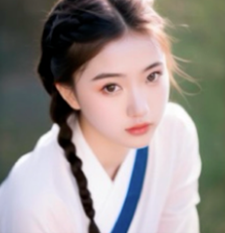Beijing Internet Court rules that AI-generated content is eligible for copyright protection (2024)
ZHU Zhigang and Paul Ranjard, first published by IAM
The portrait

This portrait is not a photograph, and the girl displayed in the portrait does not exist. It was created by Stable Diffusion – open-source software – under the guidance of Li Yunkai, who then published the portrait on the Internet. When the defendant Liu Yuanchun posted an article using the portrait without Li Yunkai’s authorisation, he sued her before the Beijing Internet Court. On 17 November 2023, the Beijing Internet Court ruled in favour of the plaintiff.
The main issue was whether an image generated by AI can be eligible for copyright protection.
Case details
The court ruled that throughout the entire process – from conceptualisation to final selection of the image – Li Yunkai had made intellectual inputs. He had defined the subject and its presentation using prompts to set the parameters for visual layout and composition. The court determined that these choices reflected the plaintiff’s personality. Further, the court found that, after obtaining the initial image through input prompts and parameter settings, the plaintiff had continued to add prompts and modify the parameters, constantly adjusting and refining the image until the final version was reached. Therefore, the court rejected the defence based on "mechanical intellectual achievement”.
The court went on to elaborate on its perspective on the "new generation of generative artificial intelligence technology", observing that generative AI is changing the way that people create. It is similar to the invention of the camera: before photography was invented, people needed exceptional painting skills to reproduce the objective appearance of objects, whereas today, the powerful and user-friendly camera function in smartphones makes photography accessible to all. However, as long as a photo taken with a smartphone reflects the photographer's creative intellectual input, it still qualifies as photographic work and is protected by copyright law.
Determining the author
According to Article 11 of the Copyright Law, authors are limited to natural persons, legal persons or unincorporated organisations. Therefore, AI models themselves cannot be recognised as authors under Chinese copyright law. The court thus decided that the author is the person who directly made the relevant settings to the AI model according to its needs and choices. The image is the direct result of the plaintiff’s intellectual input and reflects the plaintiff's personalised expression. Hence, the plaintiff is the author of the implicated image and holds the copyright to it.
A shift in AI jurisprudence
The eligibility of AI-generated content for copyright protection is a complex and evolving legal and ethical question. Determining this involves factors such as the level of human involvement, creativity and originality in the creation process. This criteria is very similar to the elements that courts consider when determining whether a work is original.
Such analysis in favour of AI has not always been accepted in China's judicial practice. In 2020, the same court ruled against the plaintiff in a case between Feilin Law Firm and Beijing Baidu Wangxun. The law firm had published an article ("Judicial Big Data Analysis Report on the Film and Entertainment Industry - Movie Volume, Beijing Edition") on their WeChat public account, which consisted of both textual and graphical content. On 10 September 2018 Beijing Baidu Wangxun published an article, the content of which was largely identical to the plaintiff’s piece, but it omitted sections such as the byline, introduction and search overview. The law firm sued on the grounds of copyright infringement.
The defendant argued that its article was generated by data analysis software and was not created using the plaintiff's intellectual work. In this judgment, the Beijing Internet Court agreed with the defendant, considering that the work needed to be created by a natural person. It further stated that the software developer and user of the software had not produced any creative act in relation to the article in question. Therefore, the AI-generated content did not convey "unique expressive qualities" of either party.
Key takeaways
The decision in this case shows that data analysis and artistic creation are quite different. This likely explains why the same court reached different conclusions in different applications of the copyright law. The discussion on the copyright eligibility of AI-generated content will continue and it will be crucial for experts to monitor how it unfolds.



